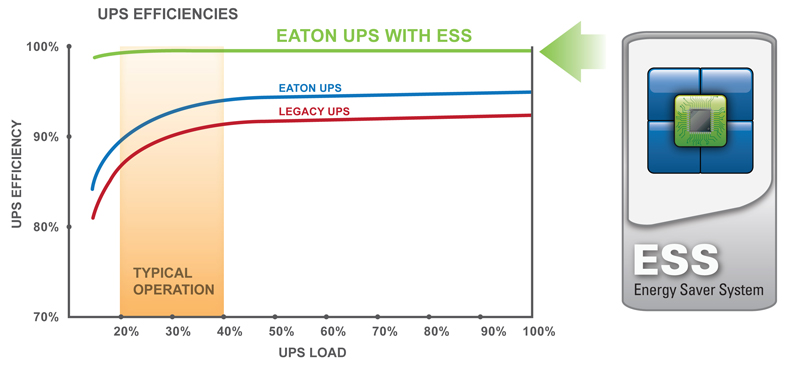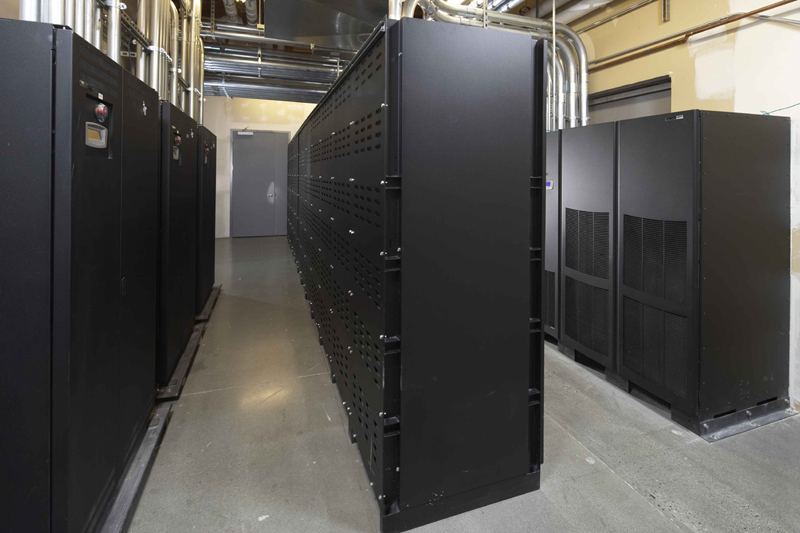Author:
Louis Pinkham, Vice President and General Manager, Critical Power Solutions, Eaton Corporation
Date
03/06/2012
NetRiver, the leading provider of collocation and interconnection services in the state of Washington, has been making data center managers green with envy — racking up hefty utility rebates, generating significant energy savings, and garnering prestigious accolades for its commitment to green efficiency. NetRiver supports two facilities that function as primary data centers for the company's 100-plus customers. Prior to revamping the Lynnwood location's power protection solution, NetRiver, like many organizations, was feeling the burden of ever-escalating power demands. Inefficiencies in uninterruptible power systems (UPSs) are a significant contributor to rising energy costs. While the efficiency of a typical UPS generally ranges from 94 to 95 percent, that rating plunges as the load decreases. And because the majority of IT systems use dual bus architecture to achieve redundancy, most UPSs are supporting loads of less than 50 percent, and often as little as 20 to 40 percent. Yet even small increases in efficiency can translate to thousands of dollars in savings, resulting from the ability to achieve more real power while lowering cooling costs — outcomes that NetRiver has experienced since deploying three 550 kVA Eaton 9395 UPSs equipped with Eaton's Energy Saver System.

In Energy Saver System mode the UPS safely provides mains current directly to the load when the input is within the acceptable limits by its voltage and frequency. If input power exceeds the predefined limits by frequency or voltage, the UPS switches to double conversion. If input power is outside the tolerances of the system, the UPS draws power from available battery modules. Detection and control algorithms continuously monitor incoming power quality and allow the UPS to engage power converters in less than two milliseconds when the utility source exceeds predefined limits by its voltage or frequency, thus always providing secured power to the critical load while maximizing efficiency. If the UPS detects a fault condition while operating in Energy Saver System, it is able to detect and determine whether the fault is caused by the load or if it is upstream from the UPS. A fault at the bypass source results in immediate switchover to the inverter; a fault in the load keeps the UPS in Energy Saver System. Using Energy Saver System, the UPS intelligently adapts to utility power conditions while supplying clean power to the connected equipment. Even more, because UPSs using Energy Saver System maintain 99 percent efficiency even when lightly loaded, the technology can deliver gains of up to 15 percentage points in efficiency over traditional models in the typical operating range. "For every one percent of efficiency gained, we save about $10,000 per year," Adam Vierra, the company's sales and marketing manager pointed out. Indeed, the data center's projected savings of 1.5 million kWh per year translates to $110,000 slashed from its annual utility bill. But that is just the beginning. To reduce the capital outlay required to install the equipment, NetRiver worked with its local utility company, Snohomish County PUD, to secure valuable incentives. The PUD offers technical advice and cash incentives, based on anticipated annual electricity savings and project type, to customers who install qualifying energy efficient equipment in new and existing facilities. The PUD allocated almost $100,000 in funding for the Eaton UPS solution. From Snohomish PUD's perspective, it was a worthy investment. "NetRiver strives to be one of the greenest data centers, and selected the most energy-efficient solutions," says Sinh Tran, senior energy efficiency program manager for the utility. "We believe in supporting customers who seek and employ innovative energy efficiency solutions." "The Eaton model allowed us to hit that 99 percent metric right off the bat," confirmed Vierra. "And we hit 99 percent efficiency at just 20 percent of load." It was the need for an additional 1.5 megawatts of clean, computer-grade power that initially prompted NetRiver's management team to consider the Eaton product line for its data center expansion. But high efficiency and bolstered power capacity were just two of the company's prerequisites for a UPS solution. As a collocation provider, NetRiver is ultra-conscious about making the most of every square foot. The company rents out space at about $35 a square foot per month, so any saved footprint is a huge advantage. Scalability was another key consideration, since NetRiver can incur unexpected, large increases in power consumption as new customers are added. With that in mind, the company desired a solution capable of easily scaling to match its unpredictable future growth. After NetRiver evaluated options from several UPS vendors, the Eaton 9395 emerged as the clear frontrunner.

"The 9395 had the smaller design, the transformerless technology, and basically all of the advantages you'd want in a UPS," Vierra explains. Furthermore, as the company's power needs increase, the units can be expanded in building-block increments by adding additional UPS modules. The trio of 9395 UPSs with Energy Saver System has also dramatically transformed the company's power usage effectiveness (PUE), a metric used to describe the energy efficiency of a data center that was created by members of the Green Grid, an industry group focused on data center energy efficiency. "We're actually at 1.3 for PUE, which is pretty phenomenal," Vierra reports. "Most companies are between 1.7 and 2. If we had adopted any other UPS, our operating costs would have been much higher and our PUE would have been much higher." In addition to the UPSs, NetRiver complemented its overall power protection solution with three Eaton power distribution units (PDUs) and five Eaton rack power panels (RPPs) — dual-fed quad panels that bring high-density power distribution closer to IT enclosures to streamline cabling while providing a more adaptable infrastructure. The PDUs and RPPs are equipped with the Eaton Energy Management System (EMS), which continuously measures the current on all breaker levels. With real-time insights into power conditions throughout the data center, managers can more effectively prevent overload conditions, optimize power distribution and track each customer's energy usage. The final touch to NetRiver's comprehensive power protection solution was the addition of an Eaton service contract. "The technology is great," Vierra says, "but the service aspect is important as well, because that is what keeps the data center completely protected. When we need something, Eaton service technicians are available and prompt," he reports. "And that's very important, because we are tied to very stringent Service Level Agreements or our customers." The upgrades have enabled NetRiver's power consumption to comprise about 35 percent of its overall operating costs, and the high efficiency UPS solution is an investment that will pay for itself many times over. The energy savings from Eaton's Energy Saver System typically recovers 100 percent of the cost of the UPS cost over just a three- to five-year time period. At a 250kW load, for example, the savings represents $4,000 per year per point of efficiency gain. Even more, from a green perspective, backing up that same load with an Energy Saver System UPS is equivalent to removing 29 cars from the road. www.powerquality.eaton.com